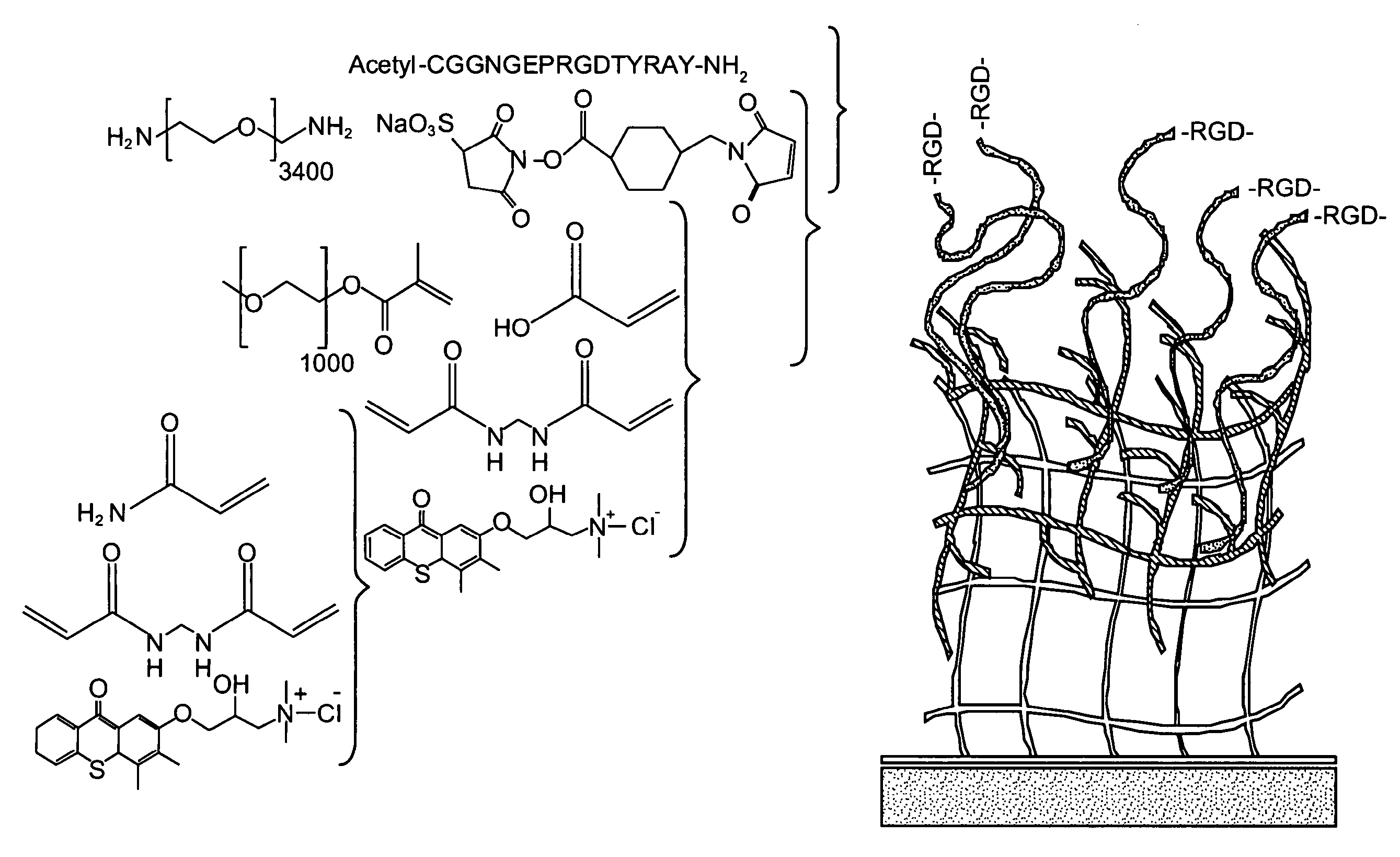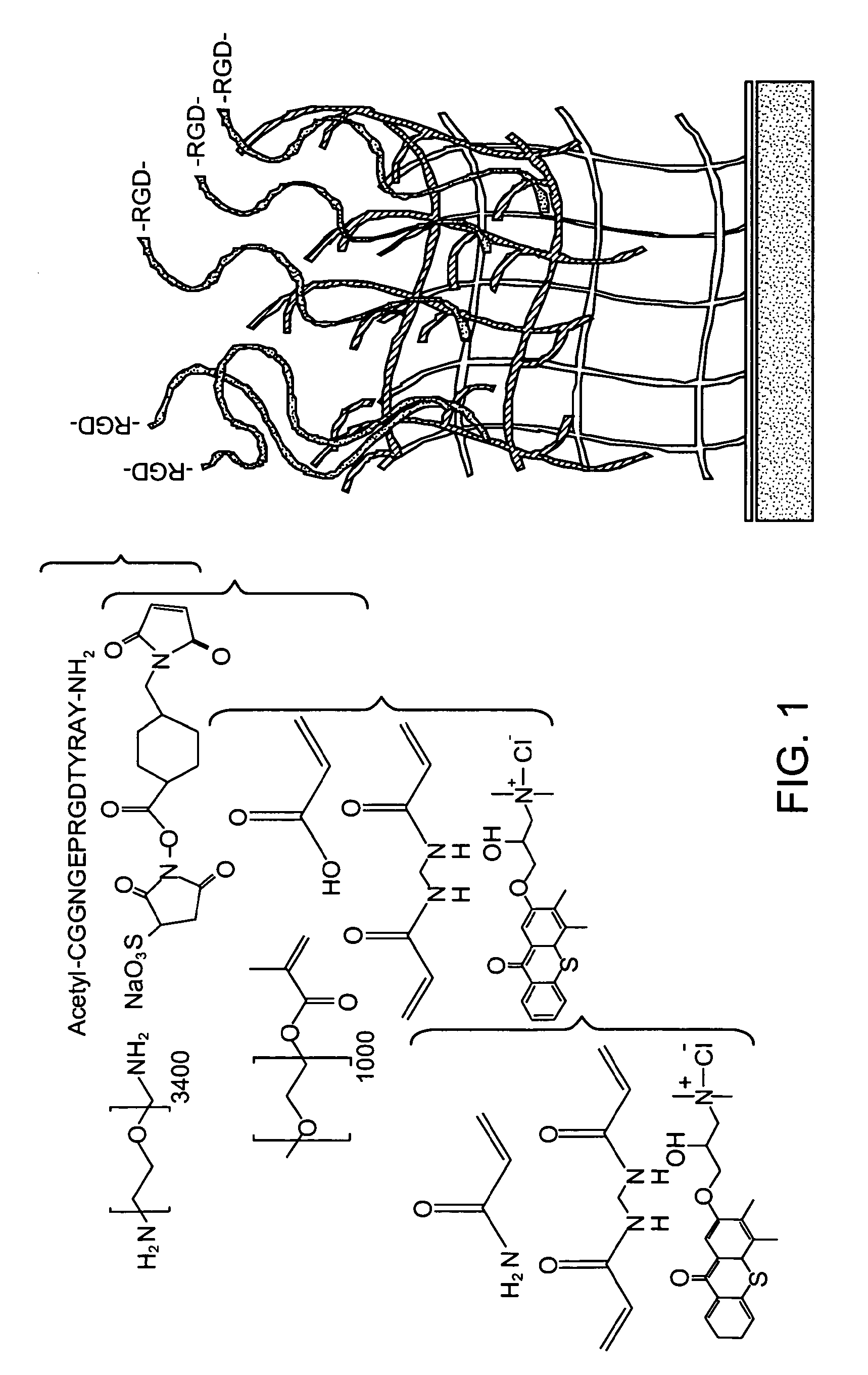Synthetic Cell Platforms and Methods of Use Thereof
a technology of synthetic cells and platforms, applied in the field of synthetic cell platforms, can solve the problems of poor cell viability of hescs or their differentiated progeny in vivo for tissue repair, limited scale-up to a clinical process for thousands or even millions of patients, and poor availability of large-scale supplies of reproducibly high-quality purified proteins
- Summary
- Abstract
- Description
- Claims
- Application Information
AI Technical Summary
Problems solved by technology
Method used
Image
Examples
example 1
Generation and Characterization of Synthetic Cell Platforms
[0087]This work was carried out with a synthetic material with highly modular ligand-presentation capabilities. Furthermore, the base material exhibits reduced non-specific interactions with constituents of the biologic environment (e.g., proteins, lipids, cells). As a first step toward creating such a platform technology, interfacial interpenetrating polymer networks (IPNs) were developed that are synthesized by sequential photoinitiated free-radical polymerization of an ultrathin layer of polyacrylamide followed by a secondary photoinitiation step using poly(ethylene glycol)-based monomers to create the network (FIG. 1)29, 30, 41 Polyacrylamide, p(AAm), and poly(ethylene glycol), pEG, are hydrophilic polymers that have demonstrated low protein, cell, and bacterial binding characteristics, and are excellent materials for precise control of cell behavior. These IPN layers based on pAAm and pEG (p(AAm-co-EG)] have been grafte...
example 2
Bacterial Peptide Display and Selection to Identify Novel Cell-Binding Peptides
[0099]As described above, bacterial display technology is particularly advantageous, since this approach enables presentation of pendant peptides on an extended surface (i.e. the bacterial cell) at densities that can be well-controlled within the range of 1,000-10,000 peptides / bacterial cell.77 To accomplish this, a novel bacterial display scaffold was developed that enables identification of peptides that retain their ability to bind to their target receptor, even when removed from the bacterial surface scaffold protein used for their isolation. In other words, peptides discovered by this approach are ideally suited for materials functionalization through grafting. This new display system enables presentation of linear or disulfide constrained peptides on the surface of bacteria as N- or C-terminal fusions to a circularly permuted variant of outer membrane protein OmpX (CPX), rather than as insertion fus...
example 3
hESCs Grown on Synthetic ECMs
[0104]The work with osteoprogenitors (FIG. 2) and neural stem cells (FIGS. 3-4) establishes the strong potential of IPN surfaces to control cell function.
[0105]The HSF6 hESC cell line, a federally approved line derived at UCSF80, was used. This line was cultured on both mouse embryonic fibroblast (MEF) feeder cells as well as a semi-interpenetrating network hydrogel system. MEFs (from CF-1 mice, Charles River) were mitotically inactivated via gamma irradiation and cultured on gelatin (collagen-derived) adsorbed to plasma-treated polystyrene (Falcon). Complete culture media (KSR) consisted of: Knockout-DMEM (Invitrogen), 20% Knockout Serum Replacement (Invitrogen), 2 mM Glutamine (Invitrogen), 0.1 mM non-essential amino acids (NEAA)(Invitrogen), 0.1 mM β-mercaptoethanol (Sigma), and 4 ng / mL FGF-2 (R&D Systems). When hESCs were cultured on sIPNs, colonies were maintained in conditioned KSR media, generated by pre-incubating KSR on MEFs for 24 hours such th...
PUM
| Property | Measurement | Unit |
|---|---|---|
| Förster radius | aaaaa | aaaaa |
| effective radius | aaaaa | aaaaa |
| thick | aaaaa | aaaaa |
Abstract
Description
Claims
Application Information
 Login to View More
Login to View More - R&D
- Intellectual Property
- Life Sciences
- Materials
- Tech Scout
- Unparalleled Data Quality
- Higher Quality Content
- 60% Fewer Hallucinations
Browse by: Latest US Patents, China's latest patents, Technical Efficacy Thesaurus, Application Domain, Technology Topic, Popular Technical Reports.
© 2025 PatSnap. All rights reserved.Legal|Privacy policy|Modern Slavery Act Transparency Statement|Sitemap|About US| Contact US: help@patsnap.com



